Chun, Wootae
Person Preferred Name
Wootae Chun
Related Works
Content type
Digital Document
Origin Information
Content type
Digital Document
Origin Information
Content type
Digital Document
Description / Synopsis
The online food delivery service industry has the potential to be one of the biggest industries in Bangladesh and contribute significantly to the economy. Technological advancement has powered the potential expansion of online food delivery services in Bangladesh. While there has been some recent research on the shift in Bangladeshi consumers' food consumption habits, there still needs to be more research on the online food delivery service industry. Noticeably, online food delivery services are only available to people living in large cities or suburban areas in Bangladesh. Rural populations have limited access to these services. The reputation of the delivery services is sometimes adversely affected by inconsistent customer service, which includes problems with order accuracy, poor user interface, and lack of responsiveness. Therefore, this study analyzes the consumers' attitudes toward using online food delivery services in Bangladesh. This study revisited the theory of the technology acceptance model (TAM) theory by retaining user motivation. According to the TAM theory, user motivation is considered as perceived ease of use and perceived usefulness, whereas in this study, perceived usefulness has been simplified by two independent variables: various food choices and time-saving orientation. Thus, the three original constructs from the TAM theory included in this study are attitudes toward using the technology, perceived ease of use, and perceived usefulness. The core objective of the study is to determine the influence of perceived ease of use, various food choices, and time-saving orientation on the consumers' attitudes toward using online food delivery services in Bangladesh. Secondly, the study examines the moderating role of the 'online shopping experience' on the user's motivation in Bangladesh.
Origin Information
Content type
Digital Document
Description / Synopsis
Being financially and technologically worse off than their counterparts in developed nations, many developing countries face natural disasters that cut them off from the rest of the world and cause excessive damage to invaluable human life and property. Sudden disasters require timely and accurate response from stakeholders to provide immediate relief while deploying scarce resources effectively. However, due to the large number of humanitarian aid agencies from different developed countries and a lack of knowledge, there is duplication of relief in many areas while countless more are left unattended. In this thesis, Resource Dependence Theory and Stakeholder Theory were employed to analyse how humanitarian organisations deliver services during a disaster. Systematic literature review was utilised for collecting data and the data was analysed using thematic analysis. During the data collection process, 300 papers were initially identified however, after further reassessment, 33 papers were left to be further analyzed. From this the researcher was able to identify that the use of Big Data in developing countries is proving to be extremely beneficial to humanitarian efforts, according to this thesis. It also explains how humanitarian organizations can make better use of big data by overcoming obstacles. The thesis suggests that increasing the number of data scientists and specialists by conducting big data training for staff, improving data governance (regulations, controls, and transparency), and enhancing privacy and security will result in major improvements in humanitarian operations. Give the importance of private stakeholders, companies' roles extend far beyond delivering profits to their shareholders, they must also address social issues by participating in disaster and humanitarian operations in developing countries.
Origin Information
Content type
Digital Document
Description / Synopsis
Consumer behavior signifies the way of people’s purchasing and consuming products and services. It is a hotbed of research which is intensely associated with human psychology and is essential for companies that are trying to sell their products or services to as many consumers as possible. Since various facets of consumers’ lives affect what they purchase and why they purchase, research on consumer behavior resolves the issues of understanding – how individuals respond to advertising and marketing, individuality – if the process can determine consumers’ personalities, social status, decision-making process. Consumer behavior research is important to determine how best to sell products or services by influencing consumers’ fears, their least healthy habits or their worst tendencies. This study has examined the relationship between consumer needs and consumer purchase behavior in terms of consumer choices of Bangladeshi customers for apparel market. Types of consumers’ choices and types of consumers’ needs are associated with each other. Types of needs are the underlying determinant of types of choices to satisfy consumers’ apparel necessity and these three categories of needs, that are recognised to satisfy apparel necessity (i.e. functional needs, social needs and experiential needs), are fulfilled by consumers through three recognised categories of choices (i.e. choice freedom, choice difficulty and choice confidence). Different categories of consumers have different types of needs and they behave differently while purchasing clothes, therefore, this study has figured out how consumers of Bangladesh make their choices according to their needs in apparel purchases. This study also examined how income levels work as a moderator while consumers make decisions. The purpose of this thesis is to shed light on the relationship of the consumers’ needs and choices. The key objective is to investigate how the correlation between consumers’ needs and choices influences the insights of consumers and their decision-making process. This study also inspected the affiliation between the needs and choices for the population with respect to certain key questions. Consequently, it identified a better understanding of the links between needs and choices and set a special consideration of how choices interact with various situations which is very important to sell the apparel products in best way. The study employed a survey research design which is quantitative in nature. Quantitative survey quantifies the problems by generating numerical data which can be converted into functional statistics and it is mostly used to measure attitudes, opinions, behaviors and any other defined variables (DeFranzo, 2011). The data was collected through a structured Likert-scale questionnaire which fulfilled the quantitative research nature. The included questions were related to the types of needs and choices theories, with focus on consumers’ purchase behavior. Therefore, it was able to investigate quantitatively due to the nature of the research. Respondents completed the questionnaire which was administrated via online electronic form through SurveyMonkey. After collecting the data, it ran ordinal regression models on the basis of dependent and independent variables of the questionnaire and that provided a clear indication of consumers’ actual preference structure. This research paper was demonstrated with the broad overview about the consumers’ choices according to the types of their needs. The study found that types of needs are positively associated with types of choices and low-income level and high-income level have decreased and increased impact accordingly with the positive relationships of needs and choices. The findings of the paper offer some valuable considerations for related theories, especially on topic of consumers’ purchase behavior by highlighting the contextual differences between needs and choices and by highlighting the other influencing factors associated with these. It contributes to build up new concepts of consumer purchase behavior theory in terms of branding theory and consumers’ needs and selection process also demonstrates that how types of needs influence consumers’ purchase decision through types of choices. Moreover, new concepts or strategies and psychological explanations of consumers help the managers to sell their products appropriately.
Origin Information
Content type
Digital Document
Description / Synopsis
Campus Sport Centres are important for university or college to retain and recruit student body, faculty, staff, and community memberships. It is important for these institutions to implement effective strategic plans that meet the needs of customers and stakeholders while remaining financially independent. The study determines how a campus sport centre can become financially self-sustaining without the need of government funding to support the operations of the facility while delivering value to its customers and stakeholders. The study used the Charles Jago Northern Sport Centre (CJNSC) of the University of Northern British Columbia (UNBC) as the case organization. The strategic priority for the CJNSC is to become a financially self-sustaining facility to cover costs associated with its aging facility. Through the review of secondary data and some primary data, the study identified eight key revenue streams that could be implemented by the CJNSC. These include; 1) increases to the percentage of UNBC student recreation and fitness fees that the CJNSC receives, 2) increased fees to programming and memberships, 3) forming strategic alliances, 4) space utilization, 5) sport tourism planning with seasonality of facility booking space, 6) cancellation fees for memberships, 7) a membership pricing strategy, 8) naming rights. It was determined through the case organization that reducing expenses would not have the long-term benefit for the CJNSC and only existing and new revenues would satisfy the goal of being financially self-sustaining. This information is provided through an integrative framework that could be used as a template or tool by other organizations of similar structure and system as the CJNSC to develop their sports centers for successful outcomes.
Origin Information
Content type
Digital Document
Description / Synopsis
Education marketing managers are increasingly becoming aware of the benefits of social media engagement in recruitment marketing for colleges and universities. Today’s prospective student is tech-savvy and information driven. Despite a general emphasis on social media engagement in a university marketing strategy, there is minimal research on the influence it has on university student recruitment and the amount of effort that universities should dedicate to social media engagement. Therefore, this study focuses on the influence of university social media engagement, particularly Facebook, on university student recruitment in the form of student applications.
Origin Information
Content type
Digital Document
Origin Information
Content type
Digital Document
Origin Information









